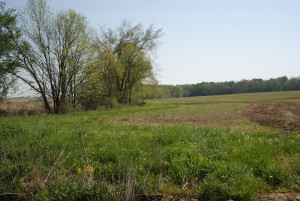
David Roehm is doing his part to bring Bobwhite quail back to Highland County, Ohio, by using the Conservation Reserve Program (CRP) to provide upland bird habitat buffers.
The Bobwhite quail has re-established its home in Ohio, and many say the reason for the return is a critical conservation effort.
Nearly 15,000 acres in southern Ohio’s Highland County are enrolled in the Conservation Reserve Program (CRP) administered by USDA’s Farm Service Agency (FSA). That’s the second largest county total in the state.
Many of the CRP practices in Highland County focus on creating Bobwhite quail habitat thanks to a partnership among Pheasants Forever, Quail Forever, U.S Fish and Wildlife Service, Ohio Division of Wildlife and USDA. Local landowners are active participants and gain significant benefits through their role.
The partnership was formed seven years ago when a natural resources professor at The Ohio State University challenged three research students to start a project to help re-establish Bobwhite quail populations in the county.
Barb Bauer, wildlife biologist with Pheasants and Quail Forever, says the high number of CRP acres in Highland County is one of the main reasons Bobwhite quail have survived.
The partners, with the help of CRP, provide financial assistance to landowners to help establish edge feathering alongside of woods, which provides a gradual transition from cropland to grasses, trees and shrubs that provide adequate cover for wildlife. The partners also offered free use of seeding drills to establish the right forbs habitat.
CRP, which is celebrating its 30th anniversary in 2015, is among the largest private lands program for conservation used extensively throughout the United States to reduce soil erosion, improve water and air quality and provide wildlife habitat.
It is a voluntary program that allows eligible landowners to receive annual rental payments and cost-share assistance to establish long-term, resource-conserving covers on eligible farmland throughout the duration of their 10-to-15-year contracts.
“Highland County has a long history of CRP involvement and we saw this project as a way to maximize the impact and benefits of CRP that address water and air quality, soil erosion and wildlife habitats,” said Jim Patton, USDA Farm Service Agency County Executive Director in Highland County.
During the first year, conservation partners started to extend habitats 30 feet from the edge of woodland areas. The student researchers did a Bobwhite quail study and thesis. Their goal was to check on local populations and identify ways to increase bird numbers.
Studies showed that a lack of grass and forbs was a limiting factor in the landscape for Bobwhite quail populations. The birds lacked ideal habitat.
The students worked with David Roehm, a landowner near Leesburg. About 40 acres of Roehm’s farm near the Fallsville Wildlife Area are enrolled in CRP. Warm-season grasses and filter strips were planted with better wildlife cover. Grass waterways were developed, too. Roehm also established edge feathering for Bobwhite quail winter cover.
“I have learned so much about my farm through the work of the graduate students and the many other partners,” said Roehm. “While we have not seen large gains in Bobwhite quail populations yet, we continue to work on the right ideas. I am seeing wildlife, such as wild turkeys, that I did not see before, so I know we are making progress.”
This spring Roehm planted additional upland bird habitat buffers in forbs and plant species next to edge-feathered sites to help enhance the habitats.
“I recommend others establish or re-establish conservation on their farm,” said Roehm. “Conservation efforts do not have to be at odds with production agriculture. It is possible to support agriculture and benefit the environment.”
Bobwhite quail populations are an indicator species of the ecosystem and food chain.
“As we lose population that indicates a breakdown of our ecosystems,” said Bauer. “Upland bird habitat buffers provide good habitat for Bobwhite quail brood rearing, and by establishing this ecosystem we help other ecosystems such as pollinator feeding habitats for the declining bee species.”
Since being established on December 23, 1985, CRP has helped prevent more than 8 billion tons of soil from eroding and protected more than 170,000 stream miles with riparian and grass buffers, more than 100,000 acres of bottomland hardwood trees, nearly 300,000 acres of flood-plain wetlands, and 250,000 acres each for duck nesting habitat and upland bird habitat.
2015 marks the 30th Anniversary of CRP. For an interactive tour of CRP success stories from across the U.S., please visit the FSA CRP 30th Anniversary website at http://www.fsa.usda.gov/CRPis30.






One Response to USDA and Partners Bring Bobwhite Quail Back to Ohio’s Highland County